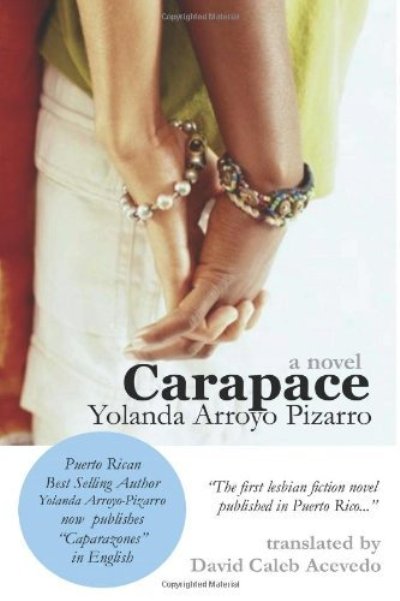I am not the one who cums. It’s her mouth. Alexia’s mouth cums inside me. Shortly before, just by a few seconds, her fingers have ejaculated within me. The electricity has traversed my skins. I have several skins. She has discovered them all and has placed them over me.
Those are the opening lines of Carapace, and from the beginning I was intrigued and disoriented. This is not a straightforward lesbian romance book. It is an abstract, poetic work. At its best, it reminded me of Jeanette Winterson’s surreal, metaphorical language. I have to assume that the book reads differently in the original language, because some of the lines are clunky in a way that suggests an awkward, literal translation of a poetic turn of phrase. (For example: “The mint green place that is our mistress room lacks her physiognomy.”) There is also the occasional typo, and these factors combined can make this a difficult novel to read at times.
Still, after getting used to the style, it began to have a sort of soothing, dreamlike feel to it. Carapace reads almost as if each chapter is a journal entry: each is semi-disconnected, and some chapters are only a paragraph long. Time is not entirely linear. Sometimes it goes off on a tangent about ecoterrorism, or turtles, or newly discovered planets (all recurring topics). There are moments that veer towards magical realism, such as the “shadow” that occupies Nessa and Alexia’s home that only Alexia can see.
Though not exactly a romance, Carapace is focused on Nessa and Alexia’s relationship. It is passionate, engrossing, and definitely dysfunctional. Alexia is married to a man, and splits her time between Nessa and their child, her husband and their child, and travelling the world as she covers stories about environmentalism activism. The story is about Nessa and how she deals with Alexia and her absence. The emotion was poignant, and the poetic language helped to highlight the push-and-pull of Nessa desire and anger for Alexia. Overall, I really thought this was a beautiful book. Despite some of the issues with the translation, and that the plot circles back on itself more than it advances, I enjoyed Carapace. If you enjoy literary, poetic books that focus on emotion and language more than a strict plot, than I would recommend Carapace. I would love to hear a comparison between the original Spanish version and the English translation, because I’m sure I would have liked it even better if I could read the original. (Carapace is the “first lesbian book published in Puerto Rico.” Technically, it was written in Puerto Rico and published in Spain, but either way, I love reading lesbian books that aren’t written/set in the West, and I hope that the translation of Carapace is a sign of more to come!)
This has been a sponsored review. For more information on sponsored reviews, please check out the Lesbrary’s review policy.




Elijah Snow says
Uhm… It was published in Puerto Rico first by Boreales, and then it was published in Spain. Let’s have our facts clear, shall we?
Danika @ The Lesbrary says
Sorry, I was just going off the Amazon page, which says “Carapace is the first lesbian fiction novel written in Puerto Rico, then published by Editorial Egales in Spain”.